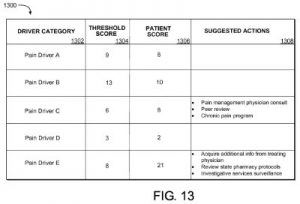In 2014, there were 107.1 cases of nonfatal occupational injuries or illnesses requiring an employee to miss work for every 100,000 full-time American workers, according to the U.S. Bureau of Labor Statistics (BLS). Although this represented a decline from 2013’s workplace injury numbers, it still resulted in 1,157,410 days away from work among private, state government and local government employees. BLS statistics show that workplace injury incidence rates were highest in the industries of transportation and warehousing as well as health care and social assistance.
Currently, America is in the grip of what is officially considered by the U.S. Department of Health and Human Services (HHS) to be an opioid epidemic. In 2014, there were more deaths related to drug overdoses than had occurred in any previous year for which those numbers had been tallied. The Centers for Disease Control and Prevention (CDC) reports that 78 Americans die everyday due to an opioid overdose. From 1999 to 2014, 165,000 Americans died from such causes and the rates of opioid overdoses as well as opioid sales have quadrupled during that 15-year time period. The most common prescription drugs involved in opioid overdose cases are methadone, oxycodone and hydrocodone.
While news reports of overdose cases ramp up across the nation, one company has developed a technology which serves to predict the likelihood of an employee developing chronic pain system. New York City-based property casualty insurance firm Travelers Companies (NYSE:TRV) unveiled its Early Severity Predictor system in early April. The company hopes that the program will allow it to target those at risk of developing chronic pain and then accelerate their recovery with a customized and precise treatment regimen similar to what is prescribed in sports medicine.
There’s a relationship between chronic pain and opioid addiction that could be better understood in order to better protect the estimated 100 million chronic pain sufferers living in the U.S. Although drug crises in the past have been dealt with by making the offending substance an illegal one, the opioid epidemic centers around medications which can be legally prescribed. The growing dangers of prescription drugs are even outpacing heroin. In 2014, 1.9 million Americans over the age of 12 had a substance abuse disorder involving prescription painkillers compared to 586,000 Americans over 12 with a heroin abuse problem according to statistics reported by the American Society of Addiction Medicine (ASAM).
The Travelers Early Severity Predictor has had some success according to the company. In the 20,000 cases of workplace injury since early 2015 to which the technique was applied, 9,000 individuals were identified as being at risk of developing chronic pain. On average, the injured workers in the Early Severity Predictor program returned to work more quickly than others and medical costs were cut by 50 percent. Every year, Travelers handles more than 250,000 workplace injury claims and manages 3.5 billion medical treatments, so this system can be scaled up in a dramatic way.
Despite the risks posed by prescription opioid painkillers, they’re still the most successful tool that doctors have in their arsenal for treating symptoms of chronic and consistent pain. The 30 percent of chronic pain patients who reach successful outcomes is greater than the rate of addiction, but as many as 20 percent of patients being treated with opioids may develop an addiction or serious side effects. Opioids are highly effective, for better and for worse. A focus on the use of prescription drugs as just one component of a treatment plan, and not a cure-all, could help doctors promote better outcomes. Reports out of Massachusetts indicate that the use of marijuana as a substitute for opioid medications is being studied at some clinics in that state.
 We reached out to Travelers and were able to confirm through a spokesperson that two patent applications published this year by the U.S. Patent and Trademark Office cover technologies associated with the Early Severity Predictor project. One is U.S. Patent Application No. 20160034662, titled Systems, Methods, and Apparatus for Identifying and Mitigating Potential Chronic Pain in Patients. This would protect an apparatus with a processor determining information about a claim associated with a person including medical condition, employment information and personal information. This information is analyzed to determine an indication that a person will develop chronic pain and the processor further determines a preventative action which can arrest chronic pain development. The technology also covers a dashboard which can be displayed to insurance users, including providers and policyholders alike, which can quickly alert people to high chronic pain risks and pain drivers.
We reached out to Travelers and were able to confirm through a spokesperson that two patent applications published this year by the U.S. Patent and Trademark Office cover technologies associated with the Early Severity Predictor project. One is U.S. Patent Application No. 20160034662, titled Systems, Methods, and Apparatus for Identifying and Mitigating Potential Chronic Pain in Patients. This would protect an apparatus with a processor determining information about a claim associated with a person including medical condition, employment information and personal information. This information is analyzed to determine an indication that a person will develop chronic pain and the processor further determines a preventative action which can arrest chronic pain development. The technology also covers a dashboard which can be displayed to insurance users, including providers and policyholders alike, which can quickly alert people to high chronic pain risks and pain drivers.
 We also confirmed a related Travelers technology which can be seen in U.S. Patent Application No. 20160034664, entitled Systems, Methods, and Apparatus Facilitating Health Care Management and Prevention of Potential Chronic Pain in Patients. It protects an apparatus with a pain management server that performs a similar process of deriving medical, employment and personal information from claim information associated with a person. The server develops multiple category scores based on that information using a chronic pain prediction model which are then used to create a chronic pain risk score which can serve as an indication to take preventative action. This system helps to quantify the risk that a particular individual experiencing acute pain could develop chronic pain.
We also confirmed a related Travelers technology which can be seen in U.S. Patent Application No. 20160034664, entitled Systems, Methods, and Apparatus Facilitating Health Care Management and Prevention of Potential Chronic Pain in Patients. It protects an apparatus with a pain management server that performs a similar process of deriving medical, employment and personal information from claim information associated with a person. The server develops multiple category scores based on that information using a chronic pain prediction model which are then used to create a chronic pain risk score which can serve as an indication to take preventative action. This system helps to quantify the risk that a particular individual experiencing acute pain could develop chronic pain.
The management of chronic pain for patient comfort and the risks associated with prescription opioids have led to innovations elsewhere. Some medical tech developers have created wearable devices which provide transcutaneous electrical nerve stimulation (TENS), a technique involving the delivery of electrical pulses to crowd out pain signals being sent to the brain. At the 2016 Consumer Electronics Show, a wearable device called iTENS which was billed as the world’s first wireless TENS device controllable by iOS or Android app so that users can personally customize pain relief treatment methods. By 2022, the global market for pain management devices is forecasted to reach $8.6 billion USD according to figures released by Grand View Research. Technologies such as the Travelers Early Severity Predictor, therefore, would seem to be entering a market sector which should grow very valuable in the years to come, in terms of both finances and public health.

![[IPWatchdog Logo]](https://ipwatchdog.com/wp-content/themes/IPWatchdog%20-%202023/assets/images/temp/logo-small@2x.png)


![[Advertisement]](https://ipwatchdog.com/wp-content/uploads/2024/04/Artificial-Intelligence-2024-REPLAY-sidebar-700x500-corrected.jpg)
![[Advertisement]](https://ipwatchdog.com/wp-content/uploads/2024/04/Patent-Litigation-Masters-2024-sidebar-700x500-1.jpg)

![[Advertisement]](https://ipwatchdog.com/wp-content/uploads/2021/12/WEBINAR-336-x-280-px.png)
![[Advertisement]](https://ipwatchdog.com/wp-content/uploads/2021/12/2021-Patent-Practice-on-Demand-recorded-Feb-2021-336-x-280.jpg)
![[Advertisement]](https://ipwatchdog.com/wp-content/uploads/2021/12/Ad-4-The-Invent-Patent-System™.png)






Join the Discussion
No comments yet.